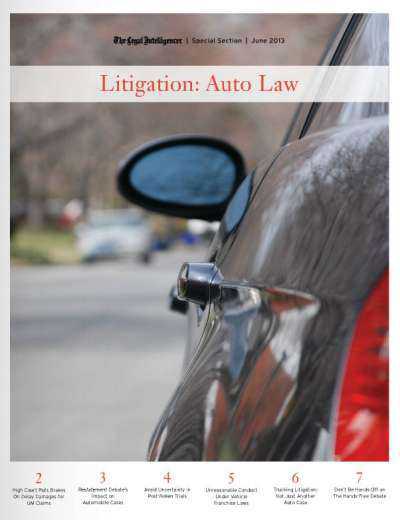Article: “Trucking Accident Litigation – It’s not just another ‘auto’ case.”

This article originally appeared in a special "Litigation: Auto Law" supplement of The Legal Intelligencer on Tuesday, June 18, 2013.
When evaluating liability in a car accident case, it is important to have knowledge of and access to the available tools – the rules of the road. There is the potential for negligence per se if a driver is speeding, failing to keep an assured clear distance, or violating other Motor Vehicle Code provisions. The introduction of a tractor-trailer or a bus into the accident adds even more “tools”. There are hundreds of potentially applicable regulations, significantly different accident dynamics, and evidence that may be lost/destroyed in short order. The important thing is to know where to look for the “tools” that might help in your evaluation.
Any driver of a tractor-trailer must have a special license that can only be obtained through special training – a Commercial Driver’s License (CDL). In 1986, the Federal government adopted The Commercial Motor Vehicle Act of 1986. However, it was not until 1992 that drivers were required to have a CDL. In furthering the interest of safe driving of commercial motor vehicles (CMVs), the Federal Motor Carrier Safety Regulations (FMCSR) were adopted to identify the minimum standards required to be followed by commercial drivers and their employers. The FMCSR places these minimum licensing and operating requirements “to help reduce or prevent truck and bus accidents, fatalities, and injuries . . .” §383.1. While there are certain exceptions (i.e.: firefighters), the regulations impose sanctions against the driver and employer for a violation. This applies to any CMV, which includes vehicles weighing in excess of 26,001 pounds, carrying hazardous materials, or with the ability to transport 16 or more passengers. §383.5.
Drivers of tractor-trailers are not only specially licensed, but they are required to pass DOT physicals. §391.41. As of August, 2012, the driver is required to submit proof of passing his physical with the DOT of his CDL State. The DOT physical requires the driver to have unimpaired upper and lower extremities (at least insofar as the impairment cannot affect grip or “normal tasks” associated with truck driving). Further, the driver should have no vision or hearing impairments, and no respiratory issues, among other health issues. Thus, while often a defendant’s medical history is not “in play” in a personal injury action, his need to be certified “healthy”, may very well call into question the truck driver’s medical condition. If the driver is just recovering from an impairment, such as a torn rotator cuff, that driver should be re-certified by a physician before returning to operating a truck, and should receive an updated physical card. These physical cards, normally valid for three years, must be pulled from a driver in the event of an injury that would no longer qualify the driver to possess a DOT physical card. This should be done by his employer. As such, when you obtain the driver’s personnel file from his employer, a photocopy of his DOT card should be in the file. If it is not, the driver can certainly produce a copy of his DOT card. The medical provider who performed the DOT physical may be subpoenaed to verify the validity of the DOT card (as this author has seen forged DOT cards from drivers, who, previously injured, never returned to the physician to be re-evaluated for an updated DOT card).
In addition to evaluating the driver, it is important to evaluate the vehicle. When a CMV is involved in an accident, depending upon the manner in which the accident occurred, certain accident related data may be stored. Vehicles are equipped with electronic information that may be referred to as an ECM, an airbag module, an EDR, etc. The point of these devices is to record a “hard brake”, fault codes, as well as other things. However, the data stored is limited. If a truck is involved in a “hard brake” concerning your accident, it may record the truck’s speed, throttle application, brake application, cruise control, RPMs, and other pertinent information for every second up to approximately one minute prior to the brake application (and it should be noted the zero point is the brake application, not the moment of the accident). It will continue to record this data for a very brief period of time after the accident. While there can be issues with this data, the electronic control data may very well tell the tale of what the CMV operator was doing in the short time leading up to and following the accident.
However, this “hard brake” data is not forever saved. Often, these devices record three hard brake events. If there are three additional hard brake events after your accident, then your accident will now be fourth in time, and may be erased. This writer has seen hard brake applications that occurred during the moving of the truck in the impound lot after an accident, thus erasing evidence (fortunately, the evidence erased were older “hard brakes” and not the hard brake in issue). It is imperative to have a qualified expert with the proper equipment to download the electronic data before it is lost. Often times trucking companies want to have their vehicle back out on the road as soon as possible as they are not making money while that truck is sitting in a parking lot. However, a well-drafted evidence preservation letter should notify the defendant not to move, alter, damage, destroy, tamper with, or perform any action whatsoever with the truck, the electronic data, or any hard data until there has been a protocol established for inspection of the truck, the download of electronic data, and the review of paper data.
As far as paper data is concerned, drivers must keep record of their hours of operation. Certainly, this does not exist in the non-commercial motor vehicle world. These records must be kept for six months pursuant to the FMCSR. §395.8. Again, a properly drafted letter of preservation will support a later claim of spoliation in the event litigation is not instituted within six months of the accident, and the driver has since destroyed his logs. The handwritten logs are important to compare to the computer data to determine whether or not the driver’s hours are consistent with the FMCSR. There are various rules, including the 11-hour rule, the 14-hour rule, the 60-hour rule, etc., that limit the amount of hours a tractor-trailer operator can drive during a day, a week, etc. These hours of service rules are important to evaluate, especially when considering if the accident occurred due to operator fatigue.
There are also issues of pleading against tractor-trailer operators (which may also apply to other commercial operators). You should consider pleading what “HIRTS” against the tractor-trailer company. Such pleadings would include theories of Hiring, Investigation, Retention, Training, and Supervision. The employer may have failed to properly investigate the qualifications of its truck drivers. Truck drivers are required to notify prospective employers of prior traffic convictions, even if they are not from truck driving. §383.31. Additional information regarding the driver’s past employment history is required as well. §383.35. The employer should carefully screen or investigate the driver before hiring him. Failure to do so may result in the hiring of an unfit operator.
Turnover is very high in the trucking industry. Drivers are often paid by the mile, and they will leave one company for another for an extra ½ cent a mile. Employers are looking to save that ½ cent when possible. There are companies in the United States that are known for hiring the “green” and the “gray”. That is, they hire less-skilled truck drivers who are right out of school, or those who are on their last mile. This saves them from paying the higher-priced “better” drivers. The problem is, a lot of these “green” drivers do not know the rules or are more willing to bend them to make early money. A lot of the “gray” drivers may not even care so much anymore. Additionally, older drivers may not have the stamina to comply with the hours of operation. It is difficult to drive a truck for 8 hours straight, which is often necessary for these drivers to be profitable. As such, an older driver may need to take more breaks, which means they have to make up the miles by working overtime. There is no overtime in truck driving (with limited exceptions) and by working overtime, they are violating the hours of operation rules.
You should endeavor to obtain the driver’s employment file, which would also reflect the companies for which he previously worked. Was he discharged from those companies for violation of his hours of service, or for being involved in “preventable” accidents”? “Preventable” and “unpreventable” accidents are terms used by the trucking industry to establish whether or not it was their particular truck driver’s fault. Simply because an accident is preventable in the general sense, may not identify whose fault the accident is. However, when a trucking company decides that the accident was “preventable”, that means they are blaming their truck driver. By obtaining his employment file, you can evaluate whether or not his current employer had obtained the records from his prior employers, the reasons for leaving his prior jobs, and any discipline. With your negligent hiring theory, you should be able to obtain those records that are important for evaluating this issue.
It is important to consider how the truck driver acts and reacts at the accident scene. Truck drivers are trained in how to respond to accidents at an accident scene. They are provided specific training to not discuss responsibility with anyone. They are provided a hotline where they will be placed in touch with a representative who will explain to them how to answer every question. In fact, if you obtain the driver’s telephone records, you will see they will typically will call their “hotline” before 911. They may have legal counsel at the accident scene, depending upon the severity of the accident. When speaking to a police officer, they are trained how to answer the questions. Before a police officer arrives, they may use “exoneration cards”. These are specific cards that are placed in their “accident kit” where they will go around the accident scene looking to find witnesses who will “exonerate” them from liability and sign one of theiran exoneration card. While most cellphones have cameras, a driver’s accident kit will also, so look for those photographs that should have been taken at the scene.
There are a number of issues that arise with trucking accidents that may not arise with your “auto” accident case. If you know where to look, you’ve increased your chances of obtaining the information you need to fully evaluate your case.

